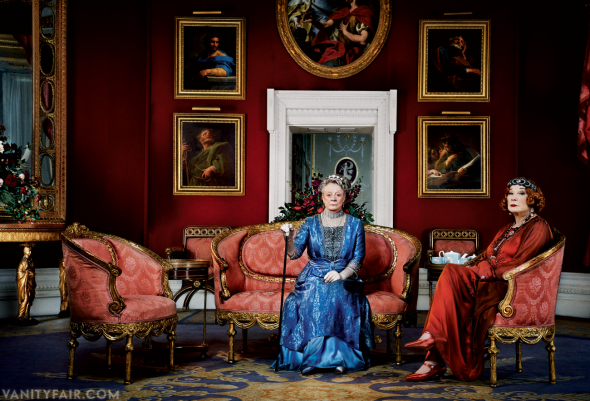More TV art history: the paintings in Downton Abbey are maybe anachronistic?
Posted: February 26, 2014 Filed under: art, tv Leave a comment[Disclaimer: I have no training in or formal education about art history – I’m just an art enthusiast. If I’m wrong about something, please let me know!]
I want to do a post on the art in House of Cards season 2, but first, a quickie on Downton Abbey Season (or “Series,” if you’re British) 4. Notably, the season finale/Christmas special was principally set at “Grantham House,” the Granthams’ house in London.
The scenes that took place in this room – the “Octagon Room” of Basildon Park – were perhaps undermined, in my opinion, by this set of distractingly arresting paintings. It really took only the most convoluted of scheming to turn my attention back to the story.
The paintings are by the 18th century Italian painter Pompeo Girolamo Batoni. In the Vanity Fair photo above, clockwise from top left, the paintings depict Saints Thomas, Peter, Matthew, and Philip. I wish this selection of saints serve as a foreshadowing for next season, but I doubt it. Anyway, some interesting stuff is contained in the National Trust descriptions of the paintings; for example, these pieces were not likely to have been exhibited in the time and place depicted in the show:
It is more unusual, as Francis Russell has said, that they should have been painted as a set of pictures for a private collection (though Rubens painted a set for the Duke of Lerma around 1611-12, and Van Dyck another for an Guilliam Verhagen around 1620/21 , for which there were precedents ), and even more so that the major part of one such set should adorn an English country house . If anything – despite the fact that the Apostles were amongst the saints that the Anglican church continued to recognise – sets of Sibyls were more common as an adornment of English country houses than were the Twelve Apostles. One reason for this was, perhaps, that paintings were very rarely collected in England for their content; if anything, they were collected in spite of it (otherwise, not only the profusion of Madonnas and Saints, but also the early English taste for Murillo, with his proliferation of child-angels, would be inexplicable). Yet even in Italy, where these particular Apostles once formed part of the greatest single concentration of Batoni’s work – the Merenda collection in Forlì – it was unusual to commission religious subjects specifically for a picture-gallery as opposed to collecting them après coup – and it normally betokened, if anything, a weakening of religious sensibility, that such was the destination for which pictures of the kind were painted. [Source]
The oval painting shown in the photo above appears to be “Cleopatra, Mark Antony and the Pearl,” by Giovanni Battista Pittoni the younger, a Venetian painter just about a generation ahead of Batoni. This painting also seems a little anachronistic to be included on the Downton set – all of these paintings didn’t come to Basildon Park until the late 1960s. However, it does illustrate an interesting and thematically resonant episode, about Cleopatra’s profligacy, which should maybe be discussed with Lord Grantham.
Somewhat relatedly, I also came across a great blog that discusses anachronisms in dialect and word usage, including an interesting post on Downton Abbey season 4.

Recent Comments